
 |
| Issue #57 - February 2009 |
 |
 |
 |
 |
 |
 |
| COVERING 3 DECADES OF GAMING | |||||
|
Table of
Contents |
| 01. Attract Mode |
| 02. Notes From Our Webmaster |
| 03. NES'cade - Excitebike |
| 04. RTM Idiocy Part 2 |
| 05. Apple II Incider - Stargate |
| 06. The Thrill Of Defeat: Zaxxon In 1K? Oh My! |
| 07. Old Wine in New Bottles: Retrogaming on Modern Hardware |
| 08. Videological Dig |
| 09. Game Over |
 |

Attract Mode by Bryan Roppolo
After reading and contributing to Retrogaming
Times through the years, both when it was hosted by Tom Zjaba
and now Alan Hewston, I decided to respond to the request for a new
editor. I have to confess that I have been slacking off a little when
it comes to classic gaming, having not updated the TI-99/4A Videogame
House website since December of last year! So hopefully becoming editor
of this legendary classic gaming magazine will light a spark under me
to get rolling again...and it already seems to have done so.
The first thing you might notice is the new layout of the magazine.
I'm not sure what people think of it, so send any comments to my
e-mail address linked above letting me know. I hope to have a flooded
Inbox with thoughts on the changes to the look so I know what people
like and don't like. I figured changing the main heading/colors of RTM
while
leaving the basic structure the same would be a
nice change, but not too much of one so that it felt like a different
magazine. My goal here was to have a more fun and colorful feel,
something which I felt was lacking previously. After all, aren't video
games all about fun and
excitement?
While I am in the spotlight I would like to mention some of the
goals
I have set for 2009 as Editor In-Chief. My first goal is to boost the
number of people that submit articles so that more information gets
covered, since we all know classic gaming covers a lot of systems and
games so there should be a lot of things to talk about that people want
to hear. Another goal is to try and bring in new readers by promoting
RTM in different places where "closet classic gamers" might be lurking.
The more viewers the better in my opinion! I might have to get Alan
Hewston to send me the site stats for each issue every month to see if
any progress is being made. Lastly, I hope to add some fun extras to
the
magazine as time goes on, such as the "This Month In History" section
which contains excerpts from newspapers/magazines for the month the
particular RTM is published, just so others can read up on what was
going on
in the classic gaming world when it wasn't so classic.
Anyway, let's get on with this first issue of the updated RTM.
Remember though to send those comments to my e-mail address on what you
think of the new image.
Greetings folks, I'm still around, but spending way too much time with my family and other hobbies lately. I wanted to let you know that we'll try to keep things going and feed you more Retro news in future issues. I'm really hoping to make the time to contribute again. Maybe we can catch up on our issues here in the next couple months to make up for being tardy this time.

Notes From Our Webmaster by Alan Hewston
Excitebike, probably one of the most classic of classic NES games. By all accounts if you owned an NES during its earlier days of mass popularity, a copy of Excitebike was more than likely in your game library. Sure, it was no Super Mario Bros. but the colorful and well designed motorbike race won over a legion of fans. Of course the big question brewing in the mind of our readers right now is, "what does Excitebike have to do with arcade gaming?" Although there was an arcade version of Excitebike that was different than the NES release, it technically was released after the Famicom version, making it a remake. However in the USA the wide release of both games was much closer to one another so I'm going to bend my own rules just a little. If anything this article should act more as an introduction to the arcade version of Excitebike and the differences to those unfamiliar with them. This makes sense since it seems that a good amount of people I've talked with over the years had no idea an arcade version existed.

NES'cade - Excitebike by David Lundin, Jr
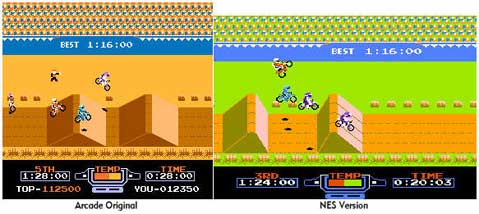 |
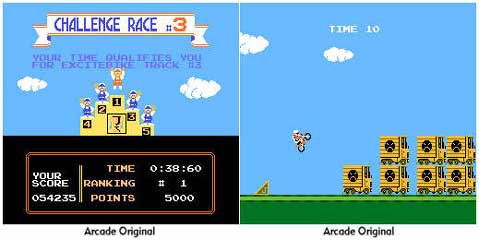 |

Computer Idiocy RTM #2 by Mark Sabbatini
One word for why I don't iPhone:
brick.
Apple's permanent disabling of phones
with "unofficial" content a while back is one of those depressingly
common occurrences where vindictiveness is seen as good customer
policy. It goes as far back in computing as I can recall, when some of
the first software copy protection schemes destroyed the data and
equipment of innocent users. As for the pirates, the corporate meanness
was just motivation to crack the latest schemes, which they inevitably
did.
As this column continues trolling for
lesser-known moments of colossal stupidity in retrocomputing history,
the much-mocked TRS-80 Color Computer remains our current microcosm.
Examples of obscure programmers trying to match the destructive
paranoia of corporate bigwigs are evident in a couple of schemes that
ruined the disk drives of countless users.
If a certain MS-DOS program from the
mid-1980s, for instance, "ran into a 'snag' it assumed that it was a
'pirated' copy and immediately trashed several sectors on drive C (the
hard drive), including directories and allocation bit maps," wrote user
GREGL in a Delphi BBS system message in 1987. The message was part of a
thread in a Color Computer forum discussing various protection schemes,
with one CoCo title portrayed as particularly vicious.
"Remember the game 'Mr. Dig?'" wrote
user DONHUTCHISON. "If the game wasn't booted from drive zero, it would
assume that the program had been pirated and would scramble the
allocation table of whatever disk was in drive zero! (It also
wrote 'BUY YOUR OWN!!!' all over the directory!)"
Another much-vilified technique,
perhaps familiar to Commodore 64 users, physically abused the floppy
disk and/or drive.
"EasyScript had a copy-protection
scheme that caused the drive head to bang against the 1541 drive’s
housing," a former owner wrote in a current-day C64 CHAT FORUM. "The
usual end result of this was to eventually misalign the drive head,
rendering the drive useless."
One of the CoCo's more odious
protection schemes forced disk drives to operate at abnormally high
speeds. Tandy initially selected a vendor making one of the lowest
quality drives ever (sticking a premium $600 price tag on them anyhow),
so a significant portion of owners found their equipment not up to the
challenge. One of the more popular CoCo software companies, Tom Mix,
got hundreds of complaints for using the drive abuse scheme on an
unauthorized Popeye clone that refused to load properly.
"Since there were a LOT of old grey
Tandy drive cases out there that WERE limited to 30 ms, this was a
serious problem," wrote Marty Goodman, one of the most knowledgeable
and opinionated CoCo users ever, and probably the most frequent poster
to the Delphi BBS. "I called the manufacturer about this after I and
friends had cracked the scheme, and WARNED him about the problem, and
urged him to change the code to a 30 ms step rate. This was,
unfortunately, not done."
The CoCo had a ROM-pack port which
Tandy – and many other companies using them – figured would curb
piracy. But CoCo users quickly figured out how to copy titles using a
few lines of BASIC code (I considered it one of my great hacking
achievements as a teen, only to be crushed when I found out many others
were just as "ingenious"). But it wasn't just the computer
manufacturers who were clueless, as politicians and legal officials
issued a barrage of confusing, conflicting and often useless decrees on
managing digital copyrights.
"In one case a while back, JS&A
was (in my opinion RIGHTLY) enjoined from making what was, in effect, a
dedicated device solely for pirating ATARI game cartridges," Goodman
wrote. "BUT the REASONS the judge gave for the decision were incredibly
stupid and actually DANGEROUS in the precedent they might set. The
cretinous chimpanzee in his black robes alleged that ROM software
should NOT enjoy the federal protection to right to back up because it
was more durable than Mag Media software. ROM's ARE quite vulnerable to
be zapped, and SHOULD be legal to back up all you want. Though in this
case JS&A was rightly stopped from making a piracy machine, it was
for the WRONG reasons."
Incidentally, Goodman's "cretinous
chimpanzees," one of his more famous phrases, will get a lot of space
in the months ahead.
Finally, users wanting to protect
their work from illegal copying could buy well-intentioned programs
containing their own loaded gun.
One disk encryption program, for
example, scrambled the contents using an algorithm based on a user
password. The unscramble option reversed the formula regardless of the
phrase entered. So an incorrect word or typo – not unheard of with the
CoCo's chiclet keyboard bounce – resulted in the contents being
scrambled into an unrecoverable mess. There was no "are you sure"
prompt or undo option.
Such oversights, which might have been
corrected with a line or two of code, were hardly uncommon during the
early days of programming. Next month will look at various programs
wreaking vast amounts of havoc on users that could have been avoided
with literally a few more minutes of effort.

Apple II Incider - Stargate by Donald Lee
| Happy February to
everyone! January has come and gone with a whirlwind of
activity. For me personally, I am a basketball official for
youth, high school and adult leagues out here in California. The
months of January/February are typically the busiest times of year
for me as there are tons of games to work. Also, my regular job
has been busy as our sales team tried to sell my company's services in
a difficult economy and they require my services as a Sales Engineer to
help out. Unless you live in a location with a large Chinese/Asian population, you may not know that the Chinese/Lunar New Year also came and went in the last couple of weeks. Just as a new year is big for all American's, the Chinese/Lunar New Year festivities is a big tradition among Chinese and other Asians. It's a time to pay respects to your elders, look back at the year past and look forward to the incoming year (Year of the Ox). As a person of Chinese heritage that was born here in the United States, I don't always follow all the traditions, but I do acknowledge the significance of the festivities. But also, let's not forget the historic moment a few weeks ago when Barack Obama took office as the first African-American president. The inauguration of President Obama was so big that my company put off a talk with our founder and now Chief Technology Officer so all of the employees could watch. With all of my personal stuff out of the way, let's turn to our favorite topic of games! 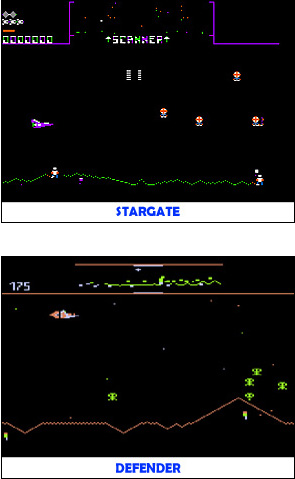 Continuing
on with my series on Atarisoft games for the Apple II, let's
take a look at Stargate. As I also played Defender
extensively on my Atari 5200, I'll include my thoughts on that
game as well. As most people know, Stargate was a sequel to the
arcade hit Defender by Williams Electronics. In all the years I
spent playing video games at various arcades, I don't think I put more
than a COUPLE OF DOLLARS (if even that much) into a Defender or
Stargate machine. Continuing
on with my series on Atarisoft games for the Apple II, let's
take a look at Stargate. As I also played Defender
extensively on my Atari 5200, I'll include my thoughts on that
game as well. As most people know, Stargate was a sequel to the
arcade hit Defender by Williams Electronics. In all the years I
spent playing video games at various arcades, I don't think I put more
than a COUPLE OF DOLLARS (if even that much) into a Defender or
Stargate machine. The main drawback to the arcade originals were obviously the controls. The complex controls of Defender and Stargate proved to be a major deterrent to me enjoying Defender and Stargate in the arcades. Thus, that is why I suck with games which had simpler controls such as Galaga and Pac-Man, among many others. However, despite my lack of interest in playing Defender in the arcades, I asked my parents to purchase Defender for my Atari 5200. It didn't take me long for me to fall in love with the game. Using a regular joystick to fly your ship was a dream. Using the two fire buttons for your ship's weapons and the keypad for hyper space was a godsend. The Atari 5200 translation of Defender was also very solid. The Defender arcade game had rather simple graphics but some great sound effects. The 5200 graphics were very close to the arcade original and the sound effects were quite spectacular. Despite playing many games on my 5200 over the years, Defender remains one of my favorites along with Space Dungeon and Mario Brothers. The Apple II version of Stargate was a bit of a curiosity. I discovered the game at my cousin's house and borrowed it to play for quite sometime. Like Defender for the Atari 5200, I never had an interest in playing Stargate in the arcades. Once again, when I played Stargate with more "regular" controls I had a great amount of fun. Stargate's overall game play is similar to Defender but there are some differences: - More Enemies - Game play is harder than the original Defender - Special Stages - A stargate exists in the playing field which the player can use to fly to humanoid's in trouble. - If you fly through he stargate with 5 humanoids in tow, you are transported ahead several levels. - Player had a cloaking shield to use. It was difficult to compare the Apple II version of Stargate to the original as I hardly played the actual arcade. I found the Apple II version of the game quite playable, and I did fairly well in the game. Despite the weaknesses of the Apple II when it came to graphics, the action with multiple objects on the screen were decent. The sound quality was pretty good and depicted most of the action you heard in the arcades (landers kidnapping humanoids, new enemies appearing, ship exploding). All in all, while fans of the Defender and Stargate originals would probably want to stick with the original controls, I personally would have preferred some simpler controls. This is reflected in how much I enjoyed the Atari and Apple versions of Defender and Stargate respectively. |

The Thrill Of Defeat: Zaxxon In 1K? Oh My! by Mark Sabbatini
People instinctively have
an irrational optimism that's been the
lifeblood of society ever since Eve thought she could get away with
eating fruit. They think politicians they vote for will keep promises,
they think their kids are virgins, they buy tickets to Chicago Cubs
games.
They kept food on the tables of lousy/unscrupulous programmers by
buying programs for the 1K Sinclair ZX81 they thought would be
entertaining.
At least 90 percent of the tapes were utter crap, duplicates of
ubiquitous simpletons like Mastermind and Horse Racing that could be
typed in from magazines in minutes. People paid $5 to $20 for
collections containing a half-dozen of those and – if they were like me
– tossed them in a drawer after a single play and went looking for
another collection that might deliver.
Amazingly, once in a while customers got their money's worth.
One kilobyte of memory, for those who missed last month's column about
gaming on the world's cheapest computer, is roughly the number of
keystrokes this column has required to this point. Take away the memory
required for the screen display (one byte for each character) and
programmers usually had a leisurely 400 to 800 bytes available.
There were a few amazing
achievements, including a 1K chess game I
referred to last month as the greatest programming effort of all time
(see screenshot, accidentally omitted from the previous column)
[Editor's Note: I included the screen shot of 1K Chess along with its
full re-printed review at the end of this article]. It can
be played online at www.zx81stuff.org.uk/zx81/indexframes.html,
which is also a source for hundreds of other games, including a few
reviewed below.
Last month's column reviewed typical – mostly drab – programs users got
stuck with. This month rewards those still here by looking mostly at 1K
gems, appreciable both for their entertainment value and impressive use
of limited memory, including homebrew efforts from recent years.
There's also some must-tries just for the preposterousness of their
claims, such as Zaxxon, Frogger and an RPG adventure.
As always, grades are strictly relative within the genre, meaning even
the best of these wouldn't fare well against titles for a ZX81 with a
16K memory expansion. For those not playable online at the site above,
information about emulators and where to find program files is provided
after the reviews.
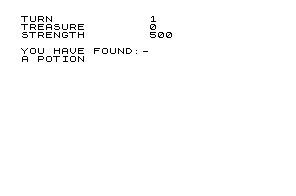 1K
Adventure (D-) Anyone with
high hopes for an adventure game on a computer without enough memory
for a typical Infocom room description might be dim enough to find some
play value here. The player starts out with 500 strength (hit points)
and each turn consists of simply hitting any key (you just know the
people who loved this are the ones who called customer service looking
for the key labeled "any"). The computer subtracts 10 hit points and
randomly decides if the player has found more strength, treasure or a
monster. The only strategy occurs if a monster is encountered, whereas
the player can fight or bribe it. Fighting subtracts up to 75 strength,
a bribe costs the same in treasure. If there aren't sufficient points
for the chosen option, RIP. I could see a combat RPG with some amount
of strategy squeezing into 1K (my thought is use the 8K of ROM data as
a map), but this ain't it. 1K
Adventure (D-) Anyone with
high hopes for an adventure game on a computer without enough memory
for a typical Infocom room description might be dim enough to find some
play value here. The player starts out with 500 strength (hit points)
and each turn consists of simply hitting any key (you just know the
people who loved this are the ones who called customer service looking
for the key labeled "any"). The computer subtracts 10 hit points and
randomly decides if the player has found more strength, treasure or a
monster. The only strategy occurs if a monster is encountered, whereas
the player can fight or bribe it. Fighting subtracts up to 75 strength,
a bribe costs the same in treasure. If there aren't sufficient points
for the chosen option, RIP. I could see a combat RPG with some amount
of strategy squeezing into 1K (my thought is use the 8K of ROM data as
a map), but this ain't it. |
 1K
Breakout (B+) (BROWSER
PLAYABLE) The only 1K game other than David Hume's legendary 1K Chess
to receive votes in a users' poll for the best ZX81 games of all time.
It features a full-screen playfield and a twist on the normal rules by
requiring players to hit the bricks ("£" characters) twice. They
turn into dollar signs after the first hit (half the value, I guess)
and disappear after the second, which causes any bricks remaining in
that row to drop a level and fill the blank space. The game is
pleasantly brisk, pauses briefly between misses and keeps score. The
biggest negative is there's only one playfield to complete (you get
nine balls for the task, but it takes a few tries to get that far). A
lesser complaint is the paddle/ball angle physics aren't great –
there's a large "center" area of the paddle where it's possible to keep
hitting the ball straight up and down. Still, of the many 1K versions,
nothing else is close. 1K
Breakout (B+) (BROWSER
PLAYABLE) The only 1K game other than David Hume's legendary 1K Chess
to receive votes in a users' poll for the best ZX81 games of all time.
It features a full-screen playfield and a twist on the normal rules by
requiring players to hit the bricks ("£" characters) twice. They
turn into dollar signs after the first hit (half the value, I guess)
and disappear after the second, which causes any bricks remaining in
that row to drop a level and fill the blank space. The game is
pleasantly brisk, pauses briefly between misses and keeps score. The
biggest negative is there's only one playfield to complete (you get
nine balls for the task, but it takes a few tries to get that far). A
lesser complaint is the paddle/ball angle physics aren't great –
there's a large "center" area of the paddle where it's possible to keep
hitting the ball straight up and down. Still, of the many 1K versions,
nothing else is close. |
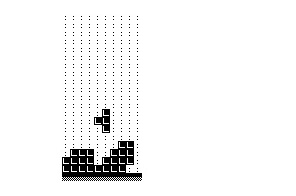 1K
Tetris (B) Russel Marks'
port of a (tired) classic finished 19th out of 61 entries in the 2002
MiniGame Compo. The blocks are made from inverse "L"s and are
surprisingly effective visually. Key layout is logical and responsive,
unlike most games that use Sinclair's illogical line of arrows on the
5-8 keys. A couple of contest judges knocked it for lacking scoring,
but Marks partially addressed this by adding a tally of vanquished
lines in 2004. Another unimpressed judge noted "there are 256-(byte)
tetris clones for PC." Maybe, but this is a commendable effort
nonetheless. 1K
Tetris (B) Russel Marks'
port of a (tired) classic finished 19th out of 61 entries in the 2002
MiniGame Compo. The blocks are made from inverse "L"s and are
surprisingly effective visually. Key layout is logical and responsive,
unlike most games that use Sinclair's illogical line of arrows on the
5-8 keys. A couple of contest judges knocked it for lacking scoring,
but Marks partially addressed this by adding a tally of vanquished
lines in 2004. Another unimpressed judge noted "there are 256-(byte)
tetris clones for PC." Maybe, but this is a commendable effort
nonetheless. |
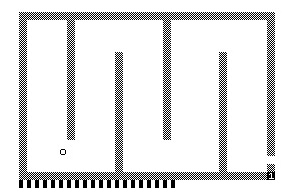 Ballmaze
(B) One of several
quality modern-era 1K games by Fernando Miguel Barletta (others are
reviewed below), this requires the player to use the (dreaded) cursor
keys to navigate a ball through seven mazes of increasing complexity
before a timer runs out. It's pure vanilla – the ball has no momentum,
moving only when the player presses a key – but I have no idea how
Barletta squeezed so much in. The mazes cover a large part of the
screen and there are little touches, such as a gauge ticking off the
time remaining, there seemingly shouldn't be room for. The timer also
gets faster after each maze and the game repeats itself if all seven
are completed. It placed 13th at the 2004 MiniGame Compo, getting mixed
reviews from the judges ("very simple, no randomness, still makes some
fun, but only for a few minutes," one wrote). It loses play value once
all the mazes are completed, but the challenge is sufficient that it
took me far more than a few minutes and the addiction factor was strong
enough to keep me trying. Ballmaze
(B) One of several
quality modern-era 1K games by Fernando Miguel Barletta (others are
reviewed below), this requires the player to use the (dreaded) cursor
keys to navigate a ball through seven mazes of increasing complexity
before a timer runs out. It's pure vanilla – the ball has no momentum,
moving only when the player presses a key – but I have no idea how
Barletta squeezed so much in. The mazes cover a large part of the
screen and there are little touches, such as a gauge ticking off the
time remaining, there seemingly shouldn't be room for. The timer also
gets faster after each maze and the game repeats itself if all seven
are completed. It placed 13th at the 2004 MiniGame Compo, getting mixed
reviews from the judges ("very simple, no randomness, still makes some
fun, but only for a few minutes," one wrote). It loses play value once
all the mazes are completed, but the challenge is sufficient that it
took me far more than a few minutes and the addiction factor was strong
enough to keep me trying. |
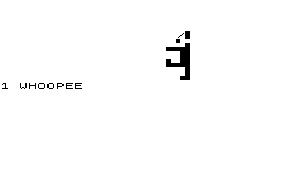 Can
Of
Worms (C-) (BROWSER
PLAYABLE) For those of you who (cough) missed last month's abundance of
crummy game collections, this offers the experience in a concept that
will either make you laugh enough to somewhat justify the cost or
disgust you to the point of throwing the computer out with the Ouija
board as a symbol of evil. Can
Of
Worms (C-) (BROWSER
PLAYABLE) For those of you who (cough) missed last month's abundance of
crummy game collections, this offers the experience in a concept that
will either make you laugh enough to somewhat justify the cost or
disgust you to the point of throwing the computer out with the Ouija
board as a symbol of evil. |
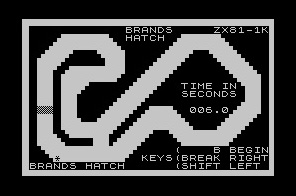 Challenge
(B+) (BROWSER
PLAYABLE) A surprisingly good five-program collection, in no small part
because it's one of the few using machine language to keep things fast
(sometime too fast). Brand's Hatch is a race around the track game
that's a whale of a short-term challenge thanks to its control scheme
and fast gameplay. Road Road is a similar but more complex concept,
requiring one or two players to steer through an overhead map of London
to a finish line nine times. Meteor Strike is a reversal of the common
"bomber" concept, as the player must rotate a map of the world so
continents aren't hit by meteors that take out everything in their path
from the top to the bottom of the map. Juggler requires moving back and
forth to keep four balls aloft, sort of like keeping four balls alive
in breakout if they were falling straight up and down. All four have
logical controls, most of which are helpfully listed on the screen, and
some offer options such as speed adjustments. The only clunker in the
collection is Cartoon Man, a mere programming exercise where an
animated man moves left or right at one of four speeds as the
appropriate keys are pressed. The one other negative is it's impossible
to tell which way the cars are facing in the racing games, which makes
their left/right steering controls more of a frustration than a
challenge for a while. Challenge
(B+) (BROWSER
PLAYABLE) A surprisingly good five-program collection, in no small part
because it's one of the few using machine language to keep things fast
(sometime too fast). Brand's Hatch is a race around the track game
that's a whale of a short-term challenge thanks to its control scheme
and fast gameplay. Road Road is a similar but more complex concept,
requiring one or two players to steer through an overhead map of London
to a finish line nine times. Meteor Strike is a reversal of the common
"bomber" concept, as the player must rotate a map of the world so
continents aren't hit by meteors that take out everything in their path
from the top to the bottom of the map. Juggler requires moving back and
forth to keep four balls aloft, sort of like keeping four balls alive
in breakout if they were falling straight up and down. All four have
logical controls, most of which are helpfully listed on the screen, and
some offer options such as speed adjustments. The only clunker in the
collection is Cartoon Man, a mere programming exercise where an
animated man moves left or right at one of four speeds as the
appropriate keys are pressed. The one other negative is it's impossible
to tell which way the cars are facing in the racing games, which makes
their left/right steering controls more of a frustration than a
challenge for a while. |
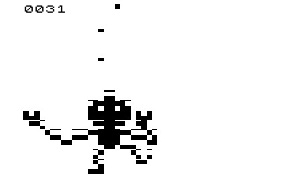 Juggle81
(B-) Wow, a Game And
Watch emulator, complete with sound on a soundless computer, that's
mostly spot-on. Pity the game really isn't that engaging. The player
controls the arms of a juggler with the left and right keys, putting
the arms in one of three positions to juggle three balls traveling
overhead at different speeds. Basically, it's a simple combination of
Kaboom and Breakout concepts. The game gets faster after every 20
catches, but it's still way too easy to figure out the movement of the
balls and keep them in play for a long time. Also, the display is
highly glitchy, something akin to the flickering in a lot of Atari 2600
games. In it's favor, it's one of a minuscule number of games with
sound, playing beeps through a hardware add-on sold back then. Juggle81
(B-) Wow, a Game And
Watch emulator, complete with sound on a soundless computer, that's
mostly spot-on. Pity the game really isn't that engaging. The player
controls the arms of a juggler with the left and right keys, putting
the arms in one of three positions to juggle three balls traveling
overhead at different speeds. Basically, it's a simple combination of
Kaboom and Breakout concepts. The game gets faster after every 20
catches, but it's still way too easy to figure out the movement of the
balls and keep them in play for a long time. Also, the display is
highly glitchy, something akin to the flickering in a lot of Atari 2600
games. In it's favor, it's one of a minuscule number of games with
sound, playing beeps through a hardware add-on sold back then. |
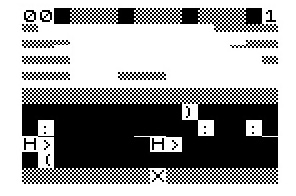 Lazyfrog
(B-) This tiny Frogger
knockoff is another game by Marks, intended for but not entered into
the MiniGame Compo (he doesn't exactly talk it up, calling it "a fairly
lazy port"). Marks says the game is probably too easy, but I found it
challenging and it's arguably better than a few of the exceeding lame
16K commercial versions for the ZX81. The player guides frogs across
four crowded lanes of traffic and four rows of logs to reach four
"home" spots. If all are filled the next wave continues at a slightly
higher speed. It keeps score and the player gets three frogs. Missing
are time limits, lady frogs, diving turtles and other "extras." Lazyfrog
(B-) This tiny Frogger
knockoff is another game by Marks, intended for but not entered into
the MiniGame Compo (he doesn't exactly talk it up, calling it "a fairly
lazy port"). Marks says the game is probably too easy, but I found it
challenging and it's arguably better than a few of the exceeding lame
16K commercial versions for the ZX81. The player guides frogs across
four crowded lanes of traffic and four rows of logs to reach four
"home" spots. If all are filled the next wave continues at a slightly
higher speed. It keeps score and the player gets three frogs. Missing
are time limits, lady frogs, diving turtles and other "extras." |
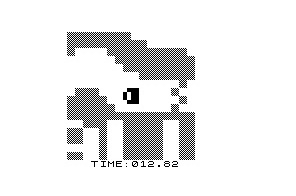 Rally
1K (B-) A one-trick pony
you'll tire of after mastering this car racing game, but an undeniably
impressive bit of programming by Fernando M. Barletta for one of the
MiniGame Compos. The player drives a car around a scrolling race track
from an overhead perspective, trying to complete a lap in the least
amount of time (20 seconds is the suggested time to beat). It will take
you longer – much longer – to complete it the first time because of the
control scheme and quirky block-graphic thing at the center of the
screen that is your car. That's not to say the graphics are bad, since
they're actually remarkable given the ZX81's 64X48 graphics resolution,
but it takes a while to figure out which of eight directions your car
is facing. Since the controls are forward, reverse and turn right or
left, that's pretty important. One really nice touch is the opening
title screen, which scrolls the track around in various directions. It
didn't score all that high in the competition ("doesn't feel like
racing, more like coaxing a LOGO turtle around a course," one judge
wrote), but it's worth a boot and maybe a half-hour of your time. Rally
1K (B-) A one-trick pony
you'll tire of after mastering this car racing game, but an undeniably
impressive bit of programming by Fernando M. Barletta for one of the
MiniGame Compos. The player drives a car around a scrolling race track
from an overhead perspective, trying to complete a lap in the least
amount of time (20 seconds is the suggested time to beat). It will take
you longer – much longer – to complete it the first time because of the
control scheme and quirky block-graphic thing at the center of the
screen that is your car. That's not to say the graphics are bad, since
they're actually remarkable given the ZX81's 64X48 graphics resolution,
but it takes a while to figure out which of eight directions your car
is facing. Since the controls are forward, reverse and turn right or
left, that's pretty important. One really nice touch is the opening
title screen, which scrolls the track around in various directions. It
didn't score all that high in the competition ("doesn't feel like
racing, more like coaxing a LOGO turtle around a course," one judge
wrote), but it's worth a boot and maybe a half-hour of your time.
|
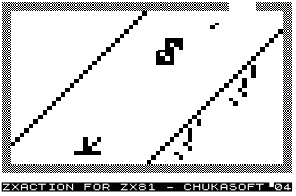 ZXAction
(C+) Zaxxon in 1K? Not
really, but this is another MiniGame entry by Barletta claiming be a
simplified version of the 3D scrolling arcade space shooter.
Graphically it's impressive within the Sinclair's limits as the jagged
space fort scrolls by endlessly at a good pace. There's a demo mode and
final score display. Gameplay is (obviously) more limited than the
arcade since the player's ship only moves left and right, all of the
targets are merely deadly obstacles to be avoided or shot (no missile
launches, fuel tank refills, etc.), and the game ends after a single
collision. Games can last a while anyhow since the difficulty level is
too easy and doesn't increase. The MiniGame judges liked this more than
I did, ranking it ninth out of 17 1K entries, four spots higher than
Ballmaze, which I consider superior. Worth playing once to appreciate
the visuals, but that's all. ZXAction
(C+) Zaxxon in 1K? Not
really, but this is another MiniGame entry by Barletta claiming be a
simplified version of the 3D scrolling arcade space shooter.
Graphically it's impressive within the Sinclair's limits as the jagged
space fort scrolls by endlessly at a good pace. There's a demo mode and
final score display. Gameplay is (obviously) more limited than the
arcade since the player's ship only moves left and right, all of the
targets are merely deadly obstacles to be avoided or shot (no missile
launches, fuel tank refills, etc.), and the game ends after a single
collision. Games can last a while anyhow since the difficulty level is
too easy and doesn't increase. The MiniGame judges liked this more than
I did, ranking it ninth out of 17 1K entries, four spots higher than
Ballmaze, which I consider superior. Worth playing once to appreciate
the visuals, but that's all. |
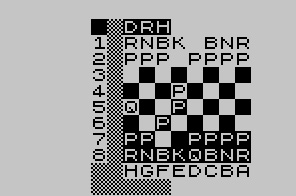 1K
Chess (A) [This is a reprinting from January's issue
(RTM 56)] Horne's effort is considered legendary and ranks as the
second-best title in an all-time ZX81 users' poll, so how can this
grade be ay lower despite some significant shortcomings? The computer
AI is beginner-level competent, with a magazine comparison of ZX81
chess games rating it five out of 10 (the best earned a nine, but all
would get their chips kicked by nearly any program on another
computer). The pieces on Horne's tiny board are represented by letters
rather than graphics ("P" for pawn, "Q" for queen, etc.), but
Sinclair's in-house chess game does the same and requires 16K (it got a
six for playing ability). The lettering is not too hard to get used to
and the game can always be played out on a real board. The computer
checks to make sure the player (who is always black) makes legal moves
and puts on an entertaining display as the moves it is considering with
flashing letters. The limited AI is somewhat redeemed by moves that are
fairly quick (advanced programs of the era can take 10 hours or more
per move). The biggest drawback is the program doesn't recognize
castling or capturing en passant, but the grade here doesn't suffer
given the impossibility of including them given the memory limits (a
version for the unexpanded 2K Timex/Sinclair 1000 includes these
moves). The only nick is for the number-letter notation for entering
moves (7E5E as an opening pawn move, for instance) instead of the
conventional letter-number approach, which resulted in some early
frustration and seems correctable without using additional memory. 1K
Chess (A) [This is a reprinting from January's issue
(RTM 56)] Horne's effort is considered legendary and ranks as the
second-best title in an all-time ZX81 users' poll, so how can this
grade be ay lower despite some significant shortcomings? The computer
AI is beginner-level competent, with a magazine comparison of ZX81
chess games rating it five out of 10 (the best earned a nine, but all
would get their chips kicked by nearly any program on another
computer). The pieces on Horne's tiny board are represented by letters
rather than graphics ("P" for pawn, "Q" for queen, etc.), but
Sinclair's in-house chess game does the same and requires 16K (it got a
six for playing ability). The lettering is not too hard to get used to
and the game can always be played out on a real board. The computer
checks to make sure the player (who is always black) makes legal moves
and puts on an entertaining display as the moves it is considering with
flashing letters. The limited AI is somewhat redeemed by moves that are
fairly quick (advanced programs of the era can take 10 hours or more
per move). The biggest drawback is the program doesn't recognize
castling or capturing en passant, but the grade here doesn't suffer
given the impossibility of including them given the memory limits (a
version for the unexpanded 2K Timex/Sinclair 1000 includes these
moves). The only nick is for the number-letter notation for entering
moves (7E5E as an opening pawn move, for instance) instead of the
conventional letter-number approach, which resulted in some early
frustration and seems correctable without using additional memory. |
There's plenty of free ZX81
emulators for nearly any computer, thanks
to the low system requirements. A good one for Windows users is
EightyOne (at www.chuntey.com), while on
my Mac I use ZXSP (http://k1.dyndns.org/Develop/projects/zxsp-osx/distributions/).
Both emulate multiple Sinclair and related machines, including the
ZX80, Spectrum and Jupiter Ace. Program files are equally easy to find
and they're so small it makes sense to simply grab various ZIP files
with hundreds of titles each (www.zx81.nl and
www.imarshall.karoo.net/zx81/zx81pfiles.htm
are two such resources).
Next month we'll really stretch the memory boundaries, relatively
speaking, with a look at games for the ZX81's U.S. near-clone, the 2K
Timex Sinclair 1000.

Old Wine in New Bottles: Retrogaming on Modern Hardware by Jonathan H. Davidson
Undoubtedly, the
Classic-era game system with the widest retro appeal is the Atari 2600.
It has been emulated on virtually every modern console. The Atari
Anthology (2004) is the second such collection of Atari 2600 games for
the PlayStation 2; it was preceded by the Activision Anthology (2002) -
and the subject of a future review.
The Atari
Anthology, published by Atari Interactive, is substantially the same as
the PC collection Atari: the 80 Classic Games (2003); that collection
was reviewed in a previous issue of RTM. This collection includes 85
games altogether; 18 Atari arcade games and 67 Atari 2600 games. Many
of the arcade games were also previously included in the Atari
Anniversary Edition Redux (2001) collection for the original
PlayStation.
Game
Selection
The arcade games
in the Anthology include everything that was ported to the 2600 (e.g.
Centipede, Asteroids, Crystal Castles, Warlords) as well as some vector
games that were not (e.g. Black Widow, Major Havoc, and Space Duel).
Presumably for historic reasons, the original Pong is also included.
The range of
Atari 2600 games is quite comprehensive! It includes roughly
three-quarters of the original Atari-made games that did not use
licensed content. Titles included range from some of very early
releases including Star Ship and Outlaw, through games released towards
the end of the system's life span such as Quadrun, Radar Lock, and Off
the Wall.
The collection
even includes a few games that saw only very limited commercial release
such as Swordquest Waterworld and Video Cube. Speaking as a Canadian
collector, the Sears exclusive titles (e.g. Submarine Commander,
Steeplechase, Stellar Trek) are especially interesting as they were
never officially sold here in Canada.
Some of the game
choices are a bit odd (e.g. Flag Capture, Slot Machine, Math Gran Prix,
Video Chess, and Fun with Numbers); I cannot image that these titles
hold much nostalgia value. There is also some redundancy with different
versions or editions of games. For example the collection includes
three different baseball games: Home Run (1978), Realsports Baseball
(1982), and Super Baseball (1988). It almost seems like the producers
were trying to pad-out the size of the collection.
Bonus
Content
The extras and
bonus content are also very comprehensive. For the 2600 games, there
are full-colour scans of all of the original game manuals, as a well as
a system manual. Some of the scans are a bit too small to read on the
TV screen and a few things are outright missing (e.g. two of the three
Swordquest comic books).
For the arcade
games, there are scans of the original sales flyers created to promote
the game to arcade operators. There are also some miscellaneous scans
of various Atari promotional items and video clips of an interview with
Atari founder Nolan Bushnell (this content is recycled from the Atari
Anniversary Edition Redux).
Unfortunately,
there is no general section on the history of Atari, or any information
about the rarity or significance of some of these games.
General
Comments
As is the case
with just about every retro game compilation I have reviewed, some
games adapt to the PlayStation 2 controllers better than others. Most
of the games were designed for a single joystick, so they have made the
transition easily. While originally designed for a trackball, Centipede
and Millipede are playable with a joystick, and Asteroids is actually
easier than with the original arcade controls.
In contrast,
games that used a spinner or paddle controls, such as Super Breakout
and, especially, Tempest are difficult to almost unplayable. Star
Raiders, which required a separate keypad, is also nearly unplayable
(there are enough buttons on the controller, but they are oddly mapped).
On the main
interface screen, the games are grouped into various categories (e.g.
Mind Games, Sports Games, Arcade Originals) and clicking on the game
launches that title. Various options, such as difficulty level, can be
set before the game is started. The arcade games provide the option of
having the original screen border; with this option enabled, I find
that the screen size is just too small to comfortably see.
Next month, we
will review yet another collection of classic games for the PlayStation
2. Feedback on this column is always welcome; please send any comments
and/or questions to jhd@interbaun.com.

Videological Dig by Bryan Roppolo
As mentioned
in the "Attract Mode" section, I am planing on adding
some extra interesting tidbits to the magazine that are not necessarily
original articles, but rather fun bits dug up from the past. The first
of these "extras" is called the "Videological Dig", which is a play on
the term Archaeological Dig. This is the section where past video game
news bytes, sound bytes, TV spots etc. will be posted so people can
experience classic gaming before it became classic. I always get a
blast digging through old newspapers, magazines, etc. and reading about
old info as it was occurring, so I hope others enjoy this new addition
as much as I enjoy finding these old articles.
For some
strange reason I am in a Sonic the Hedgehog type of mood
right now (maybe it's all the blue used in this new design), so I
looked around for some articles that mentioned the coming of Sonic on
the Genesis and found a nice article from the June 8, 1991 issue of the
Toronto Star covering the CES
show in Chicago. It might not cover Sonic that much, but it was a very
neat piece that I thought was worthy of sharing. It's written by
William Burrill and appears on page J4 of the newspaper. Not only is
there some neat hype about the Super Nintendo here, but see if you can
spot any pre-release names of games mentioned in the article.
-----------------------------------------------------------
By William Burrill, TORONTO STAR
CHICAGO - It's a bitter war.
Sixteen bits, to be precise.
At this week's Summer Consumer Electronics Show here, Nintendo finally
released it's long-awaited 16-bit Super Nintendo Entertainment System
in the United States. The Super NES is almost identical to the 16-bit
Super Famicom, released in Japan nine months ago. But crafty Nintendo
has altered the guts just enough so the U.S. Super NES won't play
Japanese Super Famicom games.
As predicted in this column earlier, the Super NES will not play the
8-bit games for the 65 million exiting NES systems. And, as I reported
in The Star earlier this week, the Super NES will not be released in
Canada until some undetermined date in 1992. The Super NES is twice as
powerful as the old 8-bit NES system. It features sharper graphics, a
multiple background scrolling rate that creates a 3-D effect, faster
game play and much greater color capacity. It's a very nifty little
piece of hardware. But, of course, the Super NES is not the first
16-bit game system on the
market. Both the Sega Genesis and NEC's TurboGrafx-16 have been around
since 1989.
So which 16-bit has the most bite? That was the question an army of
public relations and marketing people sunk their teeth into at this
convention that attracts electronic gamers from all over the world.
Nintendo came out swinging, telling buyers here in Chicago that the
Super NES is far superior to its two 16-bit rivals. "Almost every
capability of the Super NES is almost twice that of the other systems,"
Nintendo's Tim Dale told me as Super Mario bopped around in the 16-bit
Super Marioland. "The most color capacity for the competitors is 516
colors, while we have over 32,000 colors."
Nintendo even took out trade ads saying that, until the release of the
Super NES, "many of the currently available 16-bit games are really
just warmed over 8-bit versions!" Nintendo says the new Super NES
games, including Super Marioland, Castlevania IV, The Legend of Zelda
III, Sim City, Super Play Action Football, Pilotwings and F-Zero, are
the first games specifically designed to fully utilize a 16-bit system.
But Sega counter-attacked, claiming they are the real leaders in the
16-bit market, with more than 100 games already available, compared to
about a dozen
for the Super NES.
Nintendo has sold 80 per cent of the game systems now in North America,
compared to 10 per cent for Sega and 5 per cent for TurboGrafx-16. But
Sega has sold the most 16-bit systems. "If imitation is the sincerest
form of flattery then Nintendo is paying Sega the biggest compliment of
all," said Sega's Mark Smotroff. And Nintendo may have waited too long
to pay that compliment, Sega's Bob Botch figures. "We're glad they
waited," he said in an interview. "It takes programmers at least a year
or so to know what a new piece of hardware really can or can't do.
We're obviously over that curve now with the Genesis, and they're just
starting. So we'll have a software edge on them for some time."
In the Sega arcade area, one screen shows Sega's new Mario-rival, Sonic
the Hedgehog, looking sharp and crisp beside a screen showing a
suspiciously washed-out Super NES version of Super Marioland. "They
have the resolution turned way down on Mario," grumbled one Nintendo
representative. But Sega counters that Nintendo's claim of 32,000
colors to Sega's 516 is a shade misleading. "You can only see so many
colors on a TV screen," Botch said. "And I think the Genesis has
already pushed that limit pretty far."
Boom! Sega lets go another salvo, lowering the Genesis price to $149.95
(U.S.), compared to $199 for the Super NES.
Bang! Nintendo makes a surprise announcement that it and Phillips
Electronics have agreed to produce CD-ROM games for a CD player that
will plug into the Super NES. (Nintendo also has another CD game deal
with Sony Corp.)
Biff! Sega announces its own CD unit to plug into the Genesis,
available here early next year.
One company that already has a 16-bit system and a CD player attachment
on the market is NEC Inc., with its TurboGrafx-16 system. But can NEC
keep up, now that Nintendo has entered the fray, predicting to sell 2
million Super NES units this year? Based on 1991 projections, Sega says
the 1991 16- bit market share will work out to: Sega (60 per cent),
Nintendo (28 per cent), NEC TurboGrafx-16 (12 per cent).
Boffo! NEC delivers a flurry to the solar plexus by chopping its 16-bit
unit price to $99 (U.S.), thus dropping itself out of the price war
between Sega and Super NES and setting itself up as a direct competitor
to the old 8-bit NES.
Nintendo has a great new product. It'll be in stores in September
across the border. But not in Canada. "We feel Canadians haven't fully
explored all the 8-bit games yet," said Peter MacDougall,
vice-president of Nintendo Canada.
Sega watches this move with glee: "We have no idea what the logic of
that move is," Botch said. "Traditionally, when Sega ships something to
the U.S., we very quickly ship it to Canada because things go back and
forth across the border." But MacDougall doesn't see much risk of
losing business to those who shuffle off to Buffalo for the Super NES.
He's sure we'll go looking for it, but doubts we'll find many due to
high demand and low availability.
Anyway, if all this talk of corporate sumo wrestling is rotting your
brain, you get some idea how it feels to spend time as a correspondent
on the front lines of an international video game marketing war.
Gawd! No wonder they call Chicago the Windy City.
The important thing to remember is the games are the key. If these guys
try to undercut each other and the quality of the games falls
off because of the price war, we all lose. (Remember Atari, Coleco and
Intellivision, way back in the early '80s?) But if they try to outduel
each other with better games, we're into a pleasant dilemma of not
knowing which way to turn.
| |
Game Over
After completing this issue I realized I did not introduce myself
properly in the introduction. For those of you out there that don't
know me, my name is Bryan Roppolo and I've been collecting classic
video games for over 11 years (time really flies when you are having
fun). Through the years I have started up various websites for the
TI-99/4A, which was my first system that I got on Christmas 1983 when
the stores were practically giving them away (I still have a picture
from that Christmas with the boxed TI under the tree).
Collecting for the TI-99/4A has probably provided me with the most
fun of my life, from tracking down former programmers on the Internet,
to building my own websites, to helping books publish information on
the TI. Without the 99/4A, I don't know what I would be doing now and
for the most part do not want to know since I'm sure it has kept me out
of trouble through the years!
My main objectives in becoming editor of Retrogaming Times Monthly is to
help give back even more to the community that I have been apart of for
over a decade, and also to become even more involved with the hobby
that has shaped the person that I am today. It should prove to be a fun
and exciting journey to not only help continue RTM as a publication,
but making it better and hopefully more well known to people outside of
the classic gaming groups. I thank both the staff and the readers of
RTM for giving me this opportunity, since without either there would be
no RTM to edit.
- Bryan
Roppolo, Retrogaming Times Monthly Editor
Copyright
© 2009 Alan Hewston & Bryan Roppolo. All related copyrights
and trademarks are acknowledged.